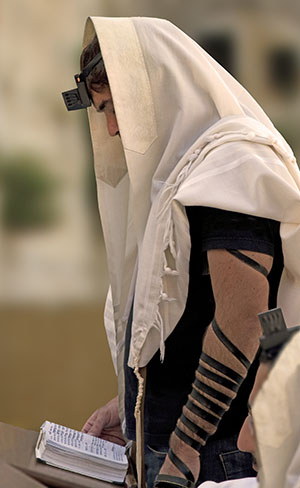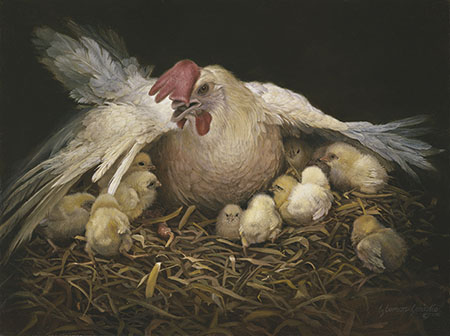Introduction
During the last week of the Savior’s mortal ministry, He condemned the hypocrisy of the scribes and Pharisees and lamented that the people of Jerusalem would not accept His love and protection.
Suggestions for Teaching
Matthew 23:1–12
The Savior condemns the hypocrisy of the scribes and Pharisees
Invite students to show their sets of scriptures to each other and to determine who has the largest set.
- • How would you respond if someone claimed that the person with the largest set of scriptures was the most righteous?
- • Why would this be an ineffective way to determine an individual’s righteousness?
- • What might happen if we determined others’ righteousness by outward appearances? (Among other problems, it might lead some people to act hypocritically.)
- • What is hypocrisy? (“The word generally denotes one who pretends to be religious when he is not” [Bible Dictionary, “Hypocrite”]. It could also refer to someone who pretends not to be religious when he or she really is.)
Explain that as part of the Savior’s final public message given at the temple in Jerusalem during the last week of His mortal ministry, He condemned the hypocrisy of the scribes and Pharisees.
Invite students to look for truths in Matthew 23 that will help them know how to respond when they see others acting hypocritically and what they can do to overcome hypocrisy in their own lives.
Invite several students to take turns reading aloud fromMatthew 23:1–7. Ask the class to follow along, looking for what the Savior said about the ways in which the scribes and Pharisees were being hypocritical. Explain that the phrase “sit in Moses’ seat” (verse 2) means the scribes and Pharisees occupied a position of authority to teach the doctrine and interpret and administer the law. The phrase could also refer to a literal seat that was found in some ancient synagogues that was reserved for those who considered themselves more worthy than anyone else in the synagogue.
- • In what ways were the scribes and Pharisees being hypocritical?

Jewish man wearing phylacteries
If available, display a picture of someone wearing phylacteries, also called tefillin. Explain that it was customary for the Jews to wear phylacteries, which were small leather boxes strapped onto the forehead and arm. Inside the phylacteries were small rolls of parchment that contained excerpts from the Hebrew scriptures. The Jews wore phylacteries to help them remember to follow God’s commandments (seeDeuteronomy 6:4–9; 11:13–21; Exodus 13:5–10, 14–16). The Lord did not condemn those who wore phylacteries, but He did condemn those who used them hypocritically or enlarged them to cause others to notice them or to appear more important.
- • According to Matthew 23:5, why did the scribes and Pharisees enlarge their phylacteries and “the borders of their garments”?
- • In what other ways did they seek “to be seen of men” (verse 5) or receive worldly honors?
- • According to the Lord’s counsel to His disciples inMatthew 23:3, what can we do when we see others acting hypocritically, or pretending to be righteous when they really are not? (Students may use different words but should identify a truth similar to the following: We can choose to obey God’s laws even if we see others acting hypocritically.)
- • Why is this truth important for us to follow in our day?
Invite a student to read Matthew 23:8 aloud, and ask the class to look for what the Lord counseled the people not to do. Invite students to report what they find.
Point out the phrase “all ye are brethren” (verse 8) and explain that the Savior taught the people not to consider themselves better than others, because they were all God’s children, equal in His sight.
Summarize Matthew 23:9–10 by explaining that the Savior testified that Heavenly Father is our Creator and that He, Christ, was sent by the Father and is our true Master who gives life (see Joseph Smith Translation, Matthew 23:6 [in Matthew 23:9, footnote a]; Matthew 23:7 [in Matthew 23:10, footnote a]).
Explain that the scribes and Pharisees thought position and status would make them great. Invite a student to read Matthew 23:11–12 aloud, and ask the class to look for who the Savior said He will consider great in the kingdom of God.
- • According to verse 11, who will be considered great in God’s kingdom?
- • According to verse 12, what will happen if we, like the Pharisees, try to “exalt” (or lift) ourselves above others? (After students respond, make sure they understand the following principle: If we try to exalt ourselves above others, we will be abased. Explain that to be abased means to be lowered or humiliated or to become less respected.)
- • According to verses 11–12, what will happen if we are humble and serve others? (Students may use different words but should identify the following principle: If we are humble and serve others, the Lord will exalt us.)
Explain that the phrase “shall be exalted” (verse 12) implies that the Lord will lift us up and help us become more like Him.
- • Based on what you have learned in Matthew 23, what does it mean to be humble?
Draw the following continuum on the board. Invite students to ponder their good works at school, home, and church. Ask them to consider where they would place themselves on this continuum based on their motives for doing good works and their efforts to be humble.
Encourage students to remember that all of us are Heavenly Father’s children. You might also encourage them to set a goal to serve someone every day for the next month. Consider inviting them to write about this experience in their personal journals.
Matthew 23:13–36
Jesus Christ declares woes upon the scribes and Pharisees
Before class begins, prepare three nontransparent cups. Smear mud or grease on the outside of the first cup and on the inside of the second cup, and leave the third cup clean. Display the cups, and ask the class which one they would prefer to drink from. Invite a student to examine the insides of the cups and to explain which cup he or she would prefer to drink from and why.
- • In what ways do the dirty cups represent hypocrites?
Summarize Matthew 23:13–36 by explaining that the Savior denounced the scribes and Pharisees for being hypocrites. Invite students to scan these verses, looking for a word the Savior repeated at the beginning of several verses. Ask them to report what they find. You may want to suggest that students mark the word woein these verses. Explain that woe refers to misery, distress, and sorrow.
Write the following scripture references and questions on the board:
Matthew 23:23–24 (see also verse 24, footnote a)
Matthew 23:29–36 (see also verse 36, footnote a)
How were the scribes and Pharisees being hypocritical?
What examples of this kind of hypocrisy do we see in our day?
Divide students into pairs. Invite each pair to read aloud each reference on the board and to discuss the questions on the board after they read each reference. (Encourage students to read the Joseph Smith Translation excerpts in the footnotes for their assigned passages.)
After sufficient time, ask students to report their answers.
Invite a student to readMatthew 23:26 aloud, and ask the class to look for what the Savior told the Pharisees to do to overcome their hypocrisy.
- • What did the Savior tell the Pharisees to do?
- • Based on what the Savior taught the Pharisees, what will happen to us as we strive to become spiritually clean on the inside? (After students respond, make sure they understand the following principle: As we strive to become spiritually clean on the inside, it will be reflected in our outward choices.)
- • What must we do to become spiritually clean on the inside?
- • How might our inner righteousness be reflected in our outward choices?
Invite students to ponder which cup best represents their current spiritual condition. Testify of the preceding principle, and encourage students to set a goal that will help them be spiritually clean.
Matthew 23:37–39
The Savior laments that the people of Jerusalem would not come to Him

Display or draw a picture of a hen protecting her chicks.
- • Why do hens gather their chicks under their wings? (To protect them from danger. Point out that a hen would sacrifice her life to protect her chicks.)
Invite a student to read Matthew 23:37–39 aloud. Ask the class to follow along, looking for how the Savior said He was like a hen.
- • How is the Savior like a hen that gathers her chicks?
- • What does it mean to be gathered by the Savior?
Point out the phrase “your house is left unto you desolate” (verse 38), and explain that desolate means empty or abandoned. Because the people were unwilling to be gathered by the Savior, they were left unprotected. This phrase could refer to the spiritual condition of the people during Jesus’s time as well as in the future when Jerusalem would be destroyed.
- • Based on what Jesus taught about a hen and her chicks, what can we receive if we are willing to be gathered by the Savior? (Students may use different words but should identify the following principle: If we are willing to be gathered by the Savior, then we will receive His care and protection.)
- • How can we show the Savior we are willing to be gathered by Him? (List students’ responses on the board.)
To help students understand one way they can gather to the Savior, invite a student to read aloud the following statement by President Henry B. Eyring of the First Presidency:

“More than once [the Savior] has said that He would gather us to Him as a hen would gather her chickens under her wings. He says that we must choose to come to Him. …
“One way to do that is to gather with the Saints in His Church. Go to your meetings, even when it seems hard. If you are determined, He will help you find the strength to do it” (“In the Strength of the Lord,” Ensign or Liahona, May 2004, 18).
- • What did President Eyring say we can do to show our willingness to be gathered by the Savior?
Ask students to look at the list on the board of ways we can show our willingness to be gathered by Christ. Invite them to share how they have received care and protection by gathering to the Savior in one of those ways.
Invite students to decide what they will do to gather to the Savior so they can continue to receive His care and protection.
Commentary and Background Information
Matthew 23. Types of hypocrisy
President N. Eldon Tanner of the First Presidency explained that there are two kinds of hypocrisy:
“Harry Emerson Fosdick observed that there are two kinds of hypocrisy: when we try to appear better than we are, and when we let ourselves appear worse than we are. We have been speaking of the kind of hypocrisy where people pretend to be more or better than they are. Too often, however, we see members of the Church who in their hearts know and believe, but through fear of public opinion fail to stand up and be counted. This kind of hypocrisy is as serious as the other” (“Woe unto You … Hypocrites,” Improvement Era, Dec. 1970, 33).
Matthew 23:35. “Zacharias son of Barachias, whom ye slew between the temple and the altar”
In the September 1842 issue of the Times and Seasons, which was published while the Prophet Joseph Smith was serving as the editor, an explanation was given concerning the fate of Zacharias, the father of John the Baptist:
“When Herod’s edict went forth to destroy the young children, John was about six months older than Jesus, and came under this hellish edict, and Zacharias caused his mother to take him into the mountains, where he was raised on locusts and wild honey. When his father refused to disclose his hiding place, and being the officiating high priest at the Temple that year, [he] was slain by Herod’s order, between the porch and the altar, as Jesus said” (“Persecution of the Prophets,” Times and Seasons, Sept. 1, 1842, 902).
Supplemental Teaching Idea
Matthew 23:13–30. Hypocrisy of the scribes and Pharisees
After asking students to read the references about hypocrisy on the board, you could distribute the following handout (with the right column blank). Invite students to fill out the chart as they look for hypocritical actions of the scribes and Pharisees as recorded in Matthew 23:13–30. Or, for variety, you could turn this into a matching exercise by shifting around the information in each cell of the chart and asking students to match each verse with its corresponding description.
VERSES INMATTHEW 23
|
HYPOCRITICAL ACTIONS OF THE SCRIBES AND PHARISEES
|
|---|---|
They not only rejected Christ, His Church, and His offer of salvation, but they also tried to prevent others from accepting Christ and salvation.
| |
They were greedy and materialistic and preyed upon others’ misfortunes.
| |
They tried to recruit others to their false beliefs.
| |
Through their oaths, they showed more reverence for the temple’s gold and furnishings than for the Lord, whom the temple honors.
| |
They obeyed rules but ignored the more important doctrines and principles the rules were based on.
| |
They hid internal greed and self-indulgence beneath an exterior show of righteousness. They looked clean and attractive externally, but internally they were corrupt and spiritually decayed.
| |
They rejected living prophets while claiming allegiance to dead prophets.
|

沒有留言:
張貼留言